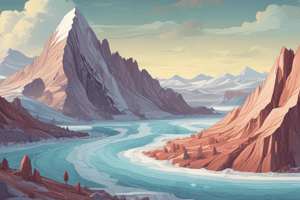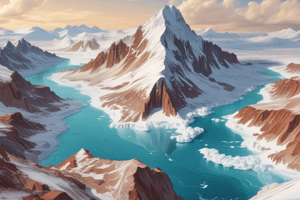Podcast
Questions and Answers
What is the primary driving force behind glacier flow?
What is the primary driving force behind glacier flow?
- Ice Thickness
- Bed Topography
- Temperature
- Gravity (correct)
What happens to snow during the compaction stage of glacier formation?
What happens to snow during the compaction stage of glacier formation?
- It is transformed into glacial ice
- It is melted into water
- It is blown away by wind
- It is compressed into firn (correct)
What type of glacier forms in mountain valleys and moves downhill due to gravity?
What type of glacier forms in mountain valleys and moves downhill due to gravity?
- Polar Glacier
- Alpine Glacier (correct)
- Cirque Glacier
- Continental Glacier
What is necessary for glacier formation to occur?
What is necessary for glacier formation to occur?
What is the process by which firn is transformed into glacial ice?
What is the process by which firn is transformed into glacial ice?
What is the term for the way glacial ice deforms and flows under its own weight?
What is the term for the way glacial ice deforms and flows under its own weight?
What type of glacier forms in high-latitude or high-altitude regions, covering large areas?
What type of glacier forms in high-latitude or high-altitude regions, covering large areas?
What is the result of snow accumulation in a high-altitude or high-latitude region?
What is the result of snow accumulation in a high-altitude or high-latitude region?
Flashcards are hidden until you start studying
Study Notes
Formation Processes
- Necessary Conditions:
- High altitude or high-latitude location
- Sufficient precipitation (snowfall) to accumulate and compact into ice
- Temperature below freezing point for an extended period
- Glacier Formation Stages:
- Accumulation: Snow falls and accumulates in a high-altitude or high-latitude region.
- Compaction: Snow is compressed into firn (granular ice) due to its own weight.
- Recrystallization: Firn is transformed into glacial ice through recrystallization.
Formation and Flow of Glaciers
- Glacier Formation Types:
- Alpine Glaciers: Form in mountain valleys and move downhill due to gravity.
- Continental Glaciers: Form in high-latitude or high-altitude regions, covering large areas.
- Glacier Flow:
- Plastic Flow: Glacial ice deforms and flows under its own weight, similar to a very viscous fluid.
- Basal Sliding: Glacial ice slides over the underlying bedrock or sediment.
- Glacier Motion Factors:
- Gravity: Primary driving force behind glacier flow.
- Ice Thickness: Thicker ice exerts more pressure, increasing flow rates.
- Temperature: Warmer temperatures increase flow rates by reducing ice viscosity.
- Bed Topography: Underlying terrain influences glacier flow patterns.
Studying That Suits You
Use AI to generate personalized quizzes and flashcards to suit your learning preferences.




